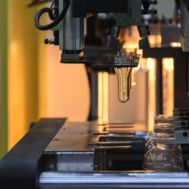
Industries

Applications

Cookie Consent
Cookies are used for statistical purposes and to improve the site.
Cookies will be used after you click "Accept" or if you continue using Dynisco.com
To find out more please review our Privacy Policy.
Correlation of melt viscosity of polyethylene terephthalate to solution intrinsic viscosity
Polyethylene terephthalate (PET) is a hygroscopic resin from the polyester family which absorbs moisture onto their molecular structure when they are exposed to the ambient air. This has a huge effect on the flow behavior and rheological parameters of the plastic melt. Normally, the moisture acts as a plasticizer and increases the flowability of the plastic melt. As a result, the melt flow rate (MFR) parameters of PET resins are strongly affected by their moisture level/drying condition and rarely provided by their suppliers. Intrinsic viscosity however; is commonly used among the PET manufactures as the specification of different resin grades. IV measurement is normally performed by dissolution of a small amount of the polymer in an appropriative solvent (e.g. phenol) at room temperature. As a result, IV parameter from dilute solution viscometer is not affected by the resin moisture content which removes the necessity of drying the samples before the tests. However; this characterization method involves with noxious solvents which may not be desirable.
Dynisco® LCR capillary rheometer series has a feature to provide correlation of shear viscosity data to the intrinsic viscosity of PET materials. The idea behind this correlation was that both zero-shear viscosity and intrinsic viscosity can be related to the molecular weight of the polymer. The reason is that, viscoelastic properties in polymer materials are dependent on molecular motion and chain entanglement. Polymers with higher molecular weight have higher chain entanglement and this can lead to the increasing of shear viscosity or intrinsic viscosity.
In polymers with high entanglement, the relationship between zero-shear viscosity and molecular weight is given by Fox-Flory equation as below [1]
𝜂0=𝐾(𝑀𝑊)3.4 equ. (1)
In a log form, the equation can be shown as
𝑙𝑛(𝜂0)=3.4𝑙𝑛(𝑀𝑊)+𝑙𝑛(𝐾) equ. (2)
Where 𝜂0 is zero-shear viscosity, and 𝐾 is a constant dependent on the polymer type. On the other hand, Mark-Houwink equation defines the relationship between intrinsic viscosity of the polymer and its molecular weight as below [2]
𝜂=𝐾′(𝑀𝑊)𝛼 equ. (3)
In a log form, the equation can be shown as
𝑙𝑛(𝜂)=𝛼𝑙𝑛(𝑀𝑊)+𝑙𝑛(𝐾') equ. (4)
Where 𝜂 is the intrinsic viscosity, and 𝐾՛ and 𝛼 are Mark-Houwink parameters and depend on a particular polymer-solvent system. For most polymers the value of 𝛼 is within 0.5-0.8. It is clear that, the changes in molecular weight of a polymer with high entanglement, affect melt viscosity more than intrinsic viscosity.
Both equations (2) and (4) are related to the molecular weight. So, melt viscosity and intrinsic viscosity can be related to each other as well. Combining these equations yields a relationship between zero-shear viscosity and intrinsic viscosity independent of molecular weight value as below
𝑙𝑛(𝜂)=𝛼/3.4𝑙𝑛(𝜂0)+𝐾" equ. (5)
where
𝐾"=𝑙𝑛 (𝐾′)−𝛼/3.4𝑙𝑛(𝐾) equ. (6)
As it can be seen, for a high entangled, linear and monodisperse polymer with narrow molecular weight distribution, the plot of logarithm of intrinsic viscosity versus logarithm of zero-shear viscosity gives a straight line with the slope of 𝛼/3.4 .
Figure 2 which has been obtained by Reilly et. al. [3] shows this relationship for a PET sample with various moisture contents. The Zero-shear viscosity values were obtained using a capillary rheometer at temperature of 285 °C. The intrinsic viscosity measurements were performed using a dilute solution viscometer at room temperature (25 °C) and the condition of 60/40 phenol/TCE.

Figure 1. Plot of shear viscosity versus shear rate for different PET samples and their resulted values of intrinsic viscosity.
Using the above relation, Dynisco® LCR capillary rheometer series can provide the information on intrinsic viscosity of PET samples by performing a shear sweep test at 285 °C. The samples need to be dried properly to reach a desired level of moisture content.
As it can bees from above picture, the resulted flow curve (apparent shear viscosity versus apparent shear rate) needs to be fitted to the cross model in order to measure the value of zero-shear viscosity.

Figure 2. Relationship between zero-shear viscosity and intrinsic viscosity of PET samples with various moisture contents.
Similarly, Dynisco® ViscoIndicator online rheometers which continually monitors the rheological properties in an extrusion line, is able to provide the information on the intrinsic viscosity of the extrudates as well. Figure 3 shows the shear viscosity and intrinsic viscosity measurements of some PET samples using a ViscoIndicator online rheometer. The samples were extruded in Dynisco® REX sampling extruder at a specific screw speed and head pressure. These information is specifically beneficial in PET recycling industry which requires the processor to continuously maintain the quality of the regrind in the recycling process.

Figure 3. Shear viscosity and intrinsic viscosity measurements of PET extrudates using a Dynisco® ViscoIndicator online rheometer
Measurement of intrinsic viscosity from melt rheometers has found a wide interest among the PET processors/recycles in plastics industry since it eliminates the sentimental and disposal issues regarding the noxious solvents. Moreover, melt flow measurements are better suited to automation and in process measurements and can provide timely input for process control [4].
References:
[1] Dealy, J. M., & Wissbrun, K. F. (2012). Melt rheology and its role in plastics processing: theory and applications. Springer Science & Business Media.
[2] Sperling, L. H. (2005). Introduction to physical polymer science. John Wiley & Sons.
[3] Reilly, J. F., & Limbach, A. P. (1994). Correlating melt rheology of PET to solution intrinsic viscosity. KAUTSCHUK UND GUMMI KUNSTSTOFFE, 47, 271-271.
[4] Whelan, T., & Brydson, J. (2202). “Practical Rheology Handbook.” Edited by. De Laney D. E., 3rd Edition, Scribd, www.scribd.com/doc/81343769/Practical-Rheology-Handbook.
Laboratory Mixing Extruder as Spinning Tool to Fibrillate Droplet Phase of Polymer Blend Systems
Correlation of Melt Viscosity of Polyethylene Terephthalate to Solution Intrinsic Viscosity
Characterizing Thermal Stability of Polymer Melts Using a Capillary Rheometer

38 Forge Parkway,
Franklin MA 02038
+1 508 541 9400
Pfaffenstr. 21, 74078,
Heilbronn, Germany
+49 7131 297 0
Lot 3615, Jalan SM 6/8
32040 Seri Manjung, Perak, Malaysia
+605 6884014